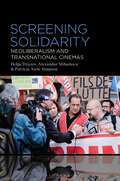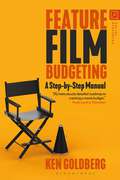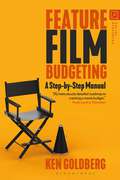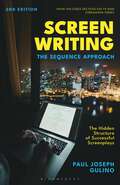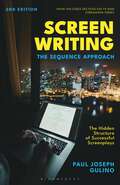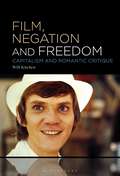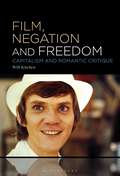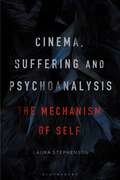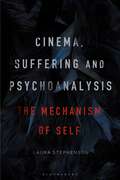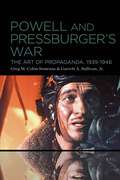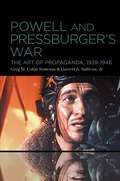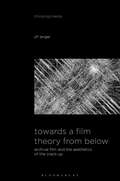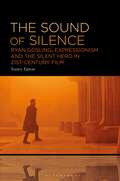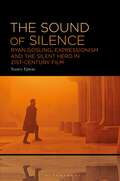- Table View
- List View
Screening Solidarity: Neoliberalism and Transnational Cinemas
by Helga Druxes Alexandar Mihailovic Patricia Anne SimpsonWestern neoliberalism is a predatory outgrowth of late capitalism that overvalues competition, transferring the laws of the market to human relationships. This book advances the argument that anti-neoliberal cinemas of Europe, the United States, and the Russian Federation imagine and visualize alternatives to the non-sovereign realities of a neoliberal workplace that unequivocally endorses dangerous risk-taking, self-optimizing neoliberal subjects, and corporate 'entrepreneurs of self.' Always at stake in the examination of neoliberalism's consequences is a human being who is indexed by race, gender, nation, ability, and economic performance. Drawing on film theory, transnational social histories, critical race theory, and Marxist and Foucauldian interpretive models, this book rediscovers a cinema that imagines a social contract focused on the common good and ethical standards for the social state. Anti-neoliberal cinema empowers the viewer as agentive through narratives that detail resistance to Western neoliberal modes of living and working. These filmmakers dramatize the labor of making solidarity across different groups.
Screening Solidarity: Neoliberalism and Transnational Cinemas
by Helga Druxes Alexandar Mihailovic Patricia Anne SimpsonWestern neoliberalism is a predatory outgrowth of late capitalism that overvalues competition, transferring the laws of the market to human relationships. This book advances the argument that anti-neoliberal cinemas of Europe, the United States, and the Russian Federation imagine and visualize alternatives to the non-sovereign realities of a neoliberal workplace that unequivocally endorses dangerous risk-taking, self-optimizing neoliberal subjects, and corporate 'entrepreneurs of self.' Always at stake in the examination of neoliberalism's consequences is a human being who is indexed by race, gender, nation, ability, and economic performance. Drawing on film theory, transnational social histories, critical race theory, and Marxist and Foucauldian interpretive models, this book rediscovers a cinema that imagines a social contract focused on the common good and ethical standards for the social state. Anti-neoliberal cinema empowers the viewer as agentive through narratives that detail resistance to Western neoliberal modes of living and working. These filmmakers dramatize the labor of making solidarity across different groups.
Cinematic Encounters with Disaster: Realisms for the Anthropocene (Thinking Cinema)
by Simon R. TroonCinematic Encounters with Disaster takes Hollywood's disaster movies and their codified versions of natural disaster, post-apocalyptic survival, and extra-terrestrial threat as the starting point for an analytical trajectory that works toward new understandings of how cinema shapes and informs our conceptions of disaster and catastrophe. It examines a range of films from distinct regional and industrial contexts: Hollywood, indie movies, different kinds of documentaries from the US and elsewhere, and auteurist-realist cinema from Europe and Asia. Moving across and beyond critical and industrial categories that often inform thinking about cinema, this book contends that different approaches to film style can push us to imagine disaster in distinct ways, with distinct ethical connotations. Framed by contemporary concerns around the global climate crisis and the advent of the Anthropocene, questions about how films can best offer responses to historical exigency guide the book's explorations of spectacular 2010s blockbusters like Gravity (2013) and San Andreas (2015), environmental documentaries including the paradigmatic An Inconvenient Truth (2006), post-disaster films by auteurs including Abbas Kiarostami and Lav Diaz, and more. Conceiving of disaster as intersubjective ethics between humans and nonhuman alterity – forces of nature, errant technology, monsters, ghosts, and other entities – it analyses how formal techniques and narrative strategies render encounters in which human protagonists are confronted with the threat of death and respond in ways that can be instructive for our planet's present juncture.
Cinematic Encounters with Disaster: Realisms for the Anthropocene (Thinking Cinema)
by Simon R. TroonCinematic Encounters with Disaster takes Hollywood's disaster movies and their codified versions of natural disaster, post-apocalyptic survival, and extra-terrestrial threat as the starting point for an analytical trajectory that works toward new understandings of how cinema shapes and informs our conceptions of disaster and catastrophe. It examines a range of films from distinct regional and industrial contexts: Hollywood, indie movies, different kinds of documentaries from the US and elsewhere, and auteurist-realist cinema from Europe and Asia. Moving across and beyond critical and industrial categories that often inform thinking about cinema, this book contends that different approaches to film style can push us to imagine disaster in distinct ways, with distinct ethical connotations. Framed by contemporary concerns around the global climate crisis and the advent of the Anthropocene, questions about how films can best offer responses to historical exigency guide the book's explorations of spectacular 2010s blockbusters like Gravity (2013) and San Andreas (2015), environmental documentaries including the paradigmatic An Inconvenient Truth (2006), post-disaster films by auteurs including Abbas Kiarostami and Lav Diaz, and more. Conceiving of disaster as intersubjective ethics between humans and nonhuman alterity – forces of nature, errant technology, monsters, ghosts, and other entities – it analyses how formal techniques and narrative strategies render encounters in which human protagonists are confronted with the threat of death and respond in ways that can be instructive for our planet's present juncture.
Feature Film Budgeting: A Step-by-Step Manual
by Ken GoldbergFeature Film Budgeting: A Step-by-Step Manual is a step-by-step guide to film budgeting in the $600k to $6.5 Million range. Be it the film student, Line Producer, 1st Assistant Director, or script writer, all will benefit from the easy-to-follow steps on how to create a film budget. This book walks the reader through how to:- find current and future salary rates for every Hollywood Guild- determine Prep and Wrap periods for all crew members- navigate the Guild contracts for easy understanding- analyze salary rates and how they were arrived at- simplify the application of fringe rates (tax percentages). Additionally, sample budgets are presented to reinforce knowledge gained in each chapter through a comprehensive breakdown. Notably, this manual covers films budgeted in the $600,000 to $6.5 Million range. This allows the reader to focus and excel at those budget levels before moving on to higher budget levels.
Feature Film Budgeting: A Step-by-Step Manual
by Ken GoldbergFeature Film Budgeting: A Step-by-Step Manual is a step-by-step guide to film budgeting in the $600k to $6.5 Million range. Be it the film student, Line Producer, 1st Assistant Director, or script writer, all will benefit from the easy-to-follow steps on how to create a film budget. This book walks the reader through how to:- find current and future salary rates for every Hollywood Guild- determine Prep and Wrap periods for all crew members- navigate the Guild contracts for easy understanding- analyze salary rates and how they were arrived at- simplify the application of fringe rates (tax percentages). Additionally, sample budgets are presented to reinforce knowledge gained in each chapter through a comprehensive breakdown. Notably, this manual covers films budgeted in the $600,000 to $6.5 Million range. This allows the reader to focus and excel at those budget levels before moving on to higher budget levels.
Screenwriting: The Sequence Approach
by Professor Paul Joseph GulinoA substantial update of the previous edition, Screenwriting: The Sequence Approach deconstructs recent feature films and offers a new section analysing popular television series.A proven screenwriting method in emotionally engaging an audience, the sequence approach emphasises the underlying motives of each story plot to better convey its relation to the work as a whole. In this expanded second edition, Paul Gulino includes analyses of recent noteworthy films and serial dramas, such as Parasite, Barry and Breaking Bad, with an eye to how they manage audience attention, convey vital information and deliver their emotional payloads. The aim of the book is to help writers move readily from the feature film to the serial form, mastering both. It is perfect for both beginning writers and those with experience in the feature screenplay form.
Screenwriting: The Sequence Approach
by Professor Paul Joseph GulinoA substantial update of the previous edition, Screenwriting: The Sequence Approach deconstructs recent feature films and offers a new section analysing popular television series.A proven screenwriting method in emotionally engaging an audience, the sequence approach emphasises the underlying motives of each story plot to better convey its relation to the work as a whole. In this expanded second edition, Paul Gulino includes analyses of recent noteworthy films and serial dramas, such as Parasite, Barry and Breaking Bad, with an eye to how they manage audience attention, convey vital information and deliver their emotional payloads. The aim of the book is to help writers move readily from the feature film to the serial form, mastering both. It is perfect for both beginning writers and those with experience in the feature screenplay form.
Film, Negation and Freedom: Capitalism and Romantic Critique
by Will KitchenFilm, Negation and Freedom: Capitalism and Romantic Critique explores cinema in relation to the critical tradition in modern philosophy and its heritage in Romantic aesthetics. Synthesising a variety of discursive fields and traditions - including Early German Romanticism, Frankfurt School critical theory and the aesthetic philosophy of Jacques Rancière - Film, Negation and Freedom outlines a radical new approach to film by re-examining the work of Arthur Penn and Lindsay Anderson. A distinction between Light and Dark Romanticism is introduced as a means of interpreting cinema's relationship with capitalism, as well as dualistic concepts such as stillness and motion, passivity and activity, pain and pleasure. Film, Negation and Freedom revitalises our understanding of modern audio-visual media, as well as the aesthetic, philosophical and political conditions of Romantic subjectivity, artistic practice and spectatorship.
Film, Negation and Freedom: Capitalism and Romantic Critique
by Will KitchenFilm, Negation and Freedom: Capitalism and Romantic Critique explores cinema in relation to the critical tradition in modern philosophy and its heritage in Romantic aesthetics. Synthesising a variety of discursive fields and traditions - including Early German Romanticism, Frankfurt School critical theory and the aesthetic philosophy of Jacques Rancière - Film, Negation and Freedom outlines a radical new approach to film by re-examining the work of Arthur Penn and Lindsay Anderson. A distinction between Light and Dark Romanticism is introduced as a means of interpreting cinema's relationship with capitalism, as well as dualistic concepts such as stillness and motion, passivity and activity, pain and pleasure. Film, Negation and Freedom revitalises our understanding of modern audio-visual media, as well as the aesthetic, philosophical and political conditions of Romantic subjectivity, artistic practice and spectatorship.
Cinema, Suffering and Psychoanalysis: The Mechanism of Self
by Laura StephensonCinema, Suffering and Psychoanalysis explores psychological disorder as common to the human condition using a unique three-angled approach: psychoanalysis recognises the inherent suffering encountered by each subject due to developmental phases; psychology applies specific categorisation to how this suffering manifests; cinema depicts suffering through a combination of video and aural elements. Functioning as a culturally reflexive medium, the six feature films analysed, including Black Swan (2010) and The Machinist (2004), represent some of the most common psychological disorders and lived experiences of the contemporary era. This book enters unchartered terrain in cinema scholarship by combining clinical psychology's Diagnostic and Statistical Manual Five (DSM-V) to organise and diagnose each character, and psychoanalysis to track the origin, mechanism and affect of the psychological disorder within the narrative trajectory of each film. Lacan's theories on the infantile mirror phase, the Imaginary, and the Symbolic, Žižek's theories on the Real, the big Other and the Event, and Kristeva's theories on abjection and melancholia work in combination with the DSM's classification of symptoms to interpret six contemporary pieces of cinema. By taking into consideration that origin, mechanism, affect and symptomatology are part of an interconnected group, this book explores psychological disorder as part of the human condition, something which contributes to and informs personal identity. More specifically, this research refutes the notion that psychological disorder and psychological health exist as a binary, instead recognising that what has traditionally been pathologised, may instead be viewed as variations on human identity.
Cinema, Suffering and Psychoanalysis: The Mechanism of Self
by Laura StephensonCinema, Suffering and Psychoanalysis explores psychological disorder as common to the human condition using a unique three-angled approach: psychoanalysis recognises the inherent suffering encountered by each subject due to developmental phases; psychology applies specific categorisation to how this suffering manifests; cinema depicts suffering through a combination of video and aural elements. Functioning as a culturally reflexive medium, the six feature films analysed, including Black Swan (2010) and The Machinist (2004), represent some of the most common psychological disorders and lived experiences of the contemporary era. This book enters unchartered terrain in cinema scholarship by combining clinical psychology's Diagnostic and Statistical Manual Five (DSM-V) to organise and diagnose each character, and psychoanalysis to track the origin, mechanism and affect of the psychological disorder within the narrative trajectory of each film. Lacan's theories on the infantile mirror phase, the Imaginary, and the Symbolic, Žižek's theories on the Real, the big Other and the Event, and Kristeva's theories on abjection and melancholia work in combination with the DSM's classification of symptoms to interpret six contemporary pieces of cinema. By taking into consideration that origin, mechanism, affect and symptomatology are part of an interconnected group, this book explores psychological disorder as part of the human condition, something which contributes to and informs personal identity. More specifically, this research refutes the notion that psychological disorder and psychological health exist as a binary, instead recognising that what has traditionally been pathologised, may instead be viewed as variations on human identity.
Powell and Pressburger’s War: The Art of Propaganda, 1939-1946
by Professor Greg M. Semenza Garrett A. Sullivan Jr.A focused study on Michael Powell and Emeric Pressburger's cinematic contributions to the war effort, arguing for the centrality of propaganda to their work as film artists.Michael Powell and Emeric Pressburger are widely hailed as two of the greatest filmmakers in British cinema history. The release of their first movie, The Spy in Black, barely preceded the beginning of World War Two, and a number of their early masterworks, including The Life and Death of Colonel Blimp, A Canterbury Tale, and A Matter of Life and Death, were produced in the service of the war effort. Through exploring the relationship between art and propaganda, this book shows that Powell and Pressburger saw no contradiction between their aesthetic ambitions and their cinematic war work: propaganda imperatives were highly conducive to their objectives as both commercial cinema practitioners and artists.Drawing on production materials from the archives of the British Film Institute, this book charts three phases in Powell and Pressburger's wartime career: from first-time collaborators who strive to reconcile popular cinematic forms with developing notions of what constitutes effective propaganda; to accomplished, and sometimes controversial, propagandists whose movies center upon Britain's relations with its enemies and allies; to filmmakers whose responsiveness to the propaganda requirements of the late war is matched by a focus, shared by the Ministry of Information, on what the post-war future would bring.
Powell and Pressburger’s War: The Art of Propaganda, 1939-1946
by Professor Greg M. Semenza Garrett A. Sullivan Jr.A focused study on Michael Powell and Emeric Pressburger's cinematic contributions to the war effort, arguing for the centrality of propaganda to their work as film artists.Michael Powell and Emeric Pressburger are widely hailed as two of the greatest filmmakers in British cinema history. The release of their first movie, The Spy in Black, barely preceded the beginning of World War Two, and a number of their early masterworks, including The Life and Death of Colonel Blimp, A Canterbury Tale, and A Matter of Life and Death, were produced in the service of the war effort. Through exploring the relationship between art and propaganda, this book shows that Powell and Pressburger saw no contradiction between their aesthetic ambitions and their cinematic war work: propaganda imperatives were highly conducive to their objectives as both commercial cinema practitioners and artists.Drawing on production materials from the archives of the British Film Institute, this book charts three phases in Powell and Pressburger's wartime career: from first-time collaborators who strive to reconcile popular cinematic forms with developing notions of what constitutes effective propaganda; to accomplished, and sometimes controversial, propagandists whose movies center upon Britain's relations with its enemies and allies; to filmmakers whose responsiveness to the propaganda requirements of the late war is matched by a focus, shared by the Ministry of Information, on what the post-war future would bring.
Towards a Film Theory from Below: Archival Film and the Aesthetics of the Crack-Up (Thinking Media)
by Jiri AngerOperating between film theory, media philosophy, archival practice, and audiovisual research, Jiri Anger focuses on the relationship between figuration and materiality in early films, experimental found footage cinema, and video essays. Would it be possible to do film theory from below, through the perspective of moving-image objects, of their multifarious details and facets, however marginal, unintentional, or aleatory they might be? Could we treat scratches, stains, and shakes in archival footage as speculatively and aesthetically generative features? Do these material actors have the capacity to create “weird shapes” within the figurative image that decenter, distort, and transform the existing conceptual and methodological frameworks?Building on his theoretical as well as practical experience with the recently digitized corpus of the first Czech films, created by Jan Kríženecký between 1898 and 1911, the author demonstrates how technological defects and accidents in archival films shape their aesthetic function and our understanding of the materiality of film in the digital age. The specific clashes between the figurative and material spheres are understood through the concept of a “crack-up.” This term, developed by Francis Scott Fitzgerald and theoretically reimagined by Gilles Deleuze, allows us to capture the convoluted relationship between figuration and materiality as inherent to the medium of film, containing negativity and productivity, difference and simultaneity, contingency and fate, at the same time, even within the tiniest cinematic units.
Towards a Film Theory from Below: Archival Film and the Aesthetics of the Crack-Up (Thinking Media)
by Jiri AngerOperating between film theory, media philosophy, archival practice, and audiovisual research, Jiri Anger focuses on the relationship between figuration and materiality in early films, experimental found footage cinema, and video essays. Would it be possible to do film theory from below, through the perspective of moving-image objects, of their multifarious details and facets, however marginal, unintentional, or aleatory they might be? Could we treat scratches, stains, and shakes in archival footage as speculatively and aesthetically generative features? Do these material actors have the capacity to create “weird shapes” within the figurative image that decenter, distort, and transform the existing conceptual and methodological frameworks?Building on his theoretical as well as practical experience with the recently digitized corpus of the first Czech films, created by Jan Kríženecký between 1898 and 1911, the author demonstrates how technological defects and accidents in archival films shape their aesthetic function and our understanding of the materiality of film in the digital age. The specific clashes between the figurative and material spheres are understood through the concept of a “crack-up.” This term, developed by Francis Scott Fitzgerald and theoretically reimagined by Gilles Deleuze, allows us to capture the convoluted relationship between figuration and materiality as inherent to the medium of film, containing negativity and productivity, difference and simultaneity, contingency and fate, at the same time, even within the tiniest cinematic units.
The Sound of Silence: Ryan Gosling, Expressionism and the Silent Hero in 21st-Century Film
by Nancy EptonThe Sound of Silence explores how non-verbal communication in film, shown primarily through the acting of Ryan Gosling, provides an expressive space in which passive audience viewing is made more active by removing the expository signifier of dialogue. The German Expressionist era may have been brief, but the shadows cast since its end nonetheless loom large. The silhouetted, cigar-wielding men of film noir and their respectively dark, doom-laden haunts mirror the angst-inducing atmospheres of their forebearers, while also introducing the now-familiar figure of the silent hero. Considering the numerous silent hero actors in film history, there's one that stands out in the 21st century like no other: Ryan Gosling. His later career has seen some of the most iconic silent heroes of the past decade, with films such as Drive, Only God Forgives, Blade Runner 2049 and First Man cementing him as the go-to guy for a monosyllabic, taciturn and moody hero whose actions speak louder than words. This book argues that it is Gosling's expressive capabilities that keep audiences compelled by his performances. With the use of non-verbal silence – combined with its counterbalance, sound – a more active, emotive audience response can be achieved. Looking further into this idea through theorists such as Michel Chion and Susan Sontag, the book demonstrates that the sound of silence is one of the most meaningful cinematic sounds of all.
The Sound of Silence: Ryan Gosling, Expressionism and the Silent Hero in 21st-Century Film
by Nancy EptonThe Sound of Silence explores how non-verbal communication in film, shown primarily through the acting of Ryan Gosling, provides an expressive space in which passive audience viewing is made more active by removing the expository signifier of dialogue. The German Expressionist era may have been brief, but the shadows cast since its end nonetheless loom large. The silhouetted, cigar-wielding men of film noir and their respectively dark, doom-laden haunts mirror the angst-inducing atmospheres of their forebearers, while also introducing the now-familiar figure of the silent hero. Considering the numerous silent hero actors in film history, there's one that stands out in the 21st century like no other: Ryan Gosling. His later career has seen some of the most iconic silent heroes of the past decade, with films such as Drive, Only God Forgives, Blade Runner 2049 and First Man cementing him as the go-to guy for a monosyllabic, taciturn and moody hero whose actions speak louder than words. This book argues that it is Gosling's expressive capabilities that keep audiences compelled by his performances. With the use of non-verbal silence – combined with its counterbalance, sound – a more active, emotive audience response can be achieved. Looking further into this idea through theorists such as Michel Chion and Susan Sontag, the book demonstrates that the sound of silence is one of the most meaningful cinematic sounds of all.
